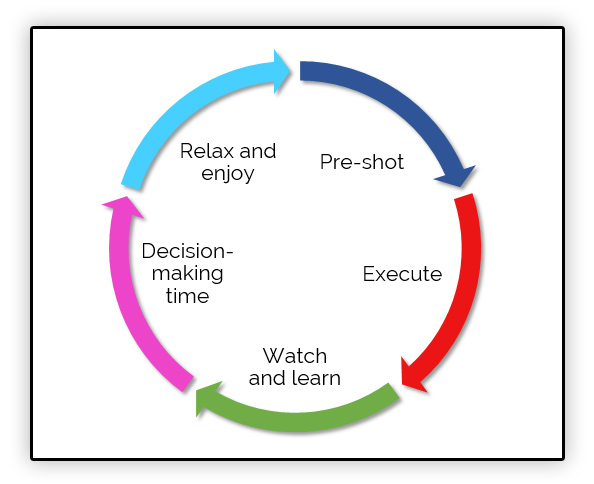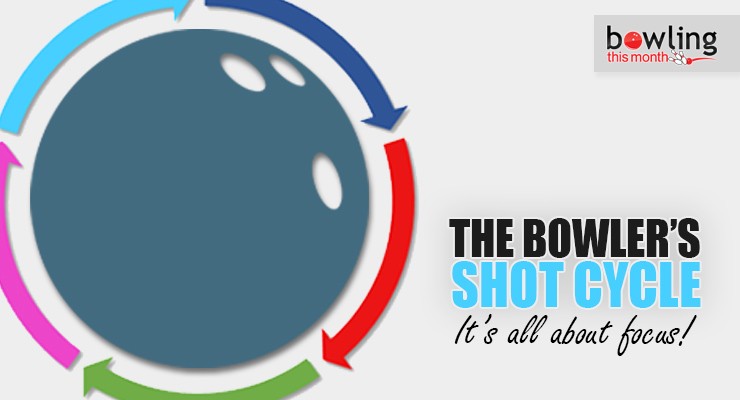Bowling is classified as a non-cyclical sport, because the repetition of movements are dispersed and varied, unlike rowing or running or cycling. That said, the sport is much more repetitive than team sports like basketball or baseball and there is very much a cycle to a bowler’s performance in league or tournament play. Bowlers that want to master the sport need to understand how to shift their focus within the cycle in order to really bowl to their potential.
What is the shot cycle?
A bowler’s typical cycle looks like this:
- Bowl the frame
- Wait
- Repeat
Within this very basic cycle framework, bowlers are required to shift their focus several times in order to stay on top of both their physical execution and their adjustments. Most people consider “focus” to be the ability to concentrate on a particular thing at a particular time, but they almost never consider that the ‘thing’ is not always the same. One of the classic ‘focus’ exercises it to stare at a particular object for 10 to 15 seconds without becoming distracted. This, however, limits focus to simply being able to concentrate on a single external stimulus. Almost nothing in life works like that.
For example, when you are driving, you must focus on lots of different stimuli happening in the environment around you, but you must also be aware of the pressure you have on the gas or brake pedal. Driving requires being focused externally on lots of different stimuli and internally on one or two. If you end up narrowing your focus too much on something in particular happening around you, like rubbernecking at an accident, you’re more likely to have one yourself. On the other hand, if you let your focus run wild and start daydreaming or texting, you are also more likely to have an accident.
Bowling, like driving, requires being focused on the right thing at the right time. Focus on the wrong things (otherwise known as being distracted) and you will miss out on information that will help you adjust, or you will simply execute poorly. To most bowlers, distractions are what happens in your peripheral vision or noises during your approach. For the purpose of bowling’s shot cycle, a distraction is focusing on anything other than what you should be focusing on.
Step 1: The pre-shot routine
It’s hard to say there is a first step in something that, by definition, is circular and repetitive, but this is as good a place to start as any. The pre-shot routine is typically how you spend the 15 to 45 seconds before starting your approach, right up to your first movement. It typically includes some kind of physical action like wiping the ball, a visual exercise like picturing the ball path, and a self-talk ritual, like “You can do this.” There are literally unlimited combinations, so we won’t go into too many details.
What’s important to remember is that the pre-shot routine is an internal exercise. You are preparing your body to execute the best shot possible. Talking to yourself, picturing things in your head, and mentally going through a checklist of actions before you start. It is also extremely specific. It requires a narrow focus to do the right thing at the right time so that it has a consistent, positive influence on your execution.
Step 2: The approach
The approach is pretty self-explanatory and is typically where most bowlers get distracted. It’s also the part of the cycle where you’ve narrowed your focus to a specific thing, most often a target.
This is narrow, external focus. It’s the part of focus that most people tend to associate with the word, and it is what the drill I described above is used for. Where most people run into problems here is when the focus gets diverted from where it should be, such as by a noise during the approach. The focus shifts to the wrong stimulus and you have a distraction.
People who don’t get distracted in this situation hear the noise just as much as anyone else, but their mind doesn’t process it because their focus is narrowed to the point that it doesn’t register on any kind of conscious level until after the shot is executed.
Step 3: Watch and learn
Step 3 starts as soon as the ball is released from your hand. In my opinion as a coach, this is where most people get distracted but they don’t even recognize it. Remember that distraction is simply not “focusing on the right thing at the right time.”
What do most bowlers see? The ball hits the target (or doesn’t). The ball hits the pins where they intended (or doesn’t). The focus is too narrow, and the bowler doesn’t pick up the cues by the ball reaction.
For higher-level bowlers, the problem doesn’t tend to be a narrow focus. They know they need to observe their ball reaction, the pin reaction, and others’ reactions as well. It requires a broad focus and they’re good at it. What mostly distracts them is themselves.
To be successful in this stage, you need to have a broad focus, on external cues. Many bowlers feel the ball come off their hand, know they’ve missed their target, and start focusing on what they did wrong and what they need to do to correct it, totally ignoring the cues the ball gives them about ball reaction. When the bowler should be focused outside themselves, they are focused internally on feel and execution.
Step 4: Decision-making time
This is the second danger zone for most bowlers. The old phrase “paralysis by analysis” refers specifically to bowlers stuck in this method of focus. When you make choices in life, you consider the information at hand, compare it to prior knowledge and experience, and make a decision of what to do next. There is generally a lot of information to consider so it requires a broad focus, and it relates specifically to your experiences, so it is most definitely internal.
Critical thinking most definitely requires a broad, internal focus. This is where some people are most comfortable spending their day. Introverts and extremely visual people can build theories, plans, and entire worlds in their heads. Since it is comfortable, it’s where some bowlers tend to stay.
The key, once you’ve reached this step, is to limit yourself to making a decision and be done with it. If you never make a decision, you can not successfully pass through this stage, no matter how good your pre-shot routine is.
Step 5: Relax and enjoy
This is probably the most important step, and it is least understood by bowlers and coaches alike. We’ve all seen those bowlers that wander around while bowling, socializing with anyone who will listen, and we tell them to “focus on what they’re doing.” After going through the first four steps, and knowing about the different kinds of focus, the question is “what do I focus on?”
You don’t want to go backwards in the cycle, and you don’t want to get stuck in a “paralysis by analysis” situation, and you can’t do your pre-shot routine for the entire 4 minutes between shots. What is a bowler supposed to do?
The answer to that question is all about awareness. Some bowlers are social butterflies and require lots of time in step 5 to really bowl at their best. Some bowlers require the same amount of time but aren’t as social, so they prefer to stay on their lanes. Observers often mistake the second group as being more focused, but they’re not.
Some bowlers require very little time in this zone and more time in step 4, or even a longer step 1 which immediately follows this step in the cycle. Most often when a bowler is confused, they spend so much time in steps 3 and 4 that they miss this step entirely. For a shot or two that might not be too bad, but over the course of a game, if you do not get to “relax and enjoy” between shots, your swing will certainly tighten up and execution will suffer no matter how good your decision-making or focus is.
You have to know what works best for you and then use that. Too much time in this zone or too little can cause problems when you try to refocus in step 1. One thing is certain: ignore this step and you will almost certainly get stuck in step 4, or burn yourself out trying to be focused.

The bowler’s shot cycle
By now, readers have probably recognized where they’ve made mistakes, and where they’re most comfortable. Everyone is most comfortable using one of the focus types in the first four steps, and since you can’t truly use both at one time, you need to develop the skill of switching from one to the other.
Hopefully, being more aware of where your focus should be will help make that process, and bowling’s shot cycle, that much easier.


